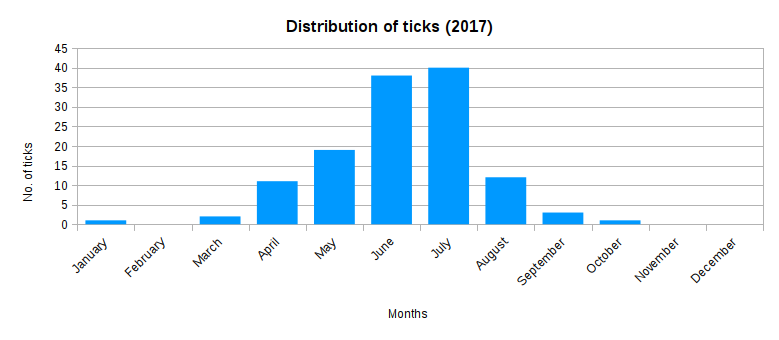We take care not to expose ourselves unnecessarily to pesticides, and we extend this precaution to our doggie companion. In particular, this means we do not use a spot-on insecticide or a tick/flea collar.
Flea and tick collars work in one of two ways, and often combine both. Some collars emit a gas which acts as a repellent for many insects. The other type of flea and tick collar has an embedded insecticide that seeps into the pet's skin, and then spreads throughout its body via their natural body oils. The fleas and ticks die when they come into contact with this insecticide.
Spot-on insecticides work in a similar way. Typically, the owner is instructed to dab the spot-on insecticide on the back of their dog's neck (or between the shoulders), where the dog cannot lick it. The spot-on insecticide then spreads over your dog's body via their natural skin oils.

Probability of Neachdainn getting a tick in this weather approaches zero
In either case an ever-present insecticide then kills the fleas or ticks. Of course, it also means your dog (or cat) is constantly exposed to the insecticide, and if you make a habit of handling your dog you will be getting a dose, too. The insecticides don't limit themselves to the dog's oil glands, they are also found in their body fat, internal organs and get excreted in their pee and jobbies.
If you have more than one animal in your household (we don't) further problems can arise. For example: one dog can lick the other's shoulder area, cats are easily harmed by insecticides designed for dogs, the insecticides designed for cats and dogs are deadly to rabbits.
So, we don't use insecticides on our pooch, but, does this mean he is overrun with pests? As far as we are aware our Scottie, Neachdainn, has never had any fleas. Ticks are an entirely different situation, as the places where we go for walkies are tick infested. All the areas are populated with wild deer, and some with sheep, both of whom are carriers for ticks. Although, as you will see, the problem is concentrated over five months in spring and summer, when the ticks are most active.
As Neachdainn gets groomed every day, immediately after his main walk, we have a good chance of removing the ticks early. Although this year was the first time that we kept tick statistics, we are pretty certain the numbers are down compared to previous years. The following chart shows the number of ticks we removed from Neachdainn in each month of 2017.

Our tick statistics chart for 2017 (no distinction made between adult ticks & nymphs).
Obviously, the year is not finished, but, I don't expect to discover any ticks in December (if we do, I will update this page).
For removing ticks we have a neat tool that has a spring loaded lasso at the end. To remove a tick: you push out the lasso, place it over the tick, let the spring tighten the lasso and then twist the whole tool which removes the tick from the skin. The same tool works just as efficiently for removing ticks from humans.
A particular concern is the tick borne Lyme Disease, which can infect both humans and dogs. Lyme Disease is caused by a bacteria carried by the tick which is transferred when the tick bites the host. The tick must be attached for at least 36-48 hours[3] before the disease can be transmited, so ideally removal should happen long before this period.
Ideally, we would like to find some natural method of detering ticks for our doggie companion, but the ones we have tested so far haven't been effective. If you have found an effective natural tick deterrent it would be great to hear about it in the comments below.
Notes
- Tick (Ixodes ricinus) image courtesy of Richard Bartz.
- This page from Mainely Ticks has a good summary of the tick life cycle.
- U.S. Department of Health & Human Services, Lyme Disease Transmission